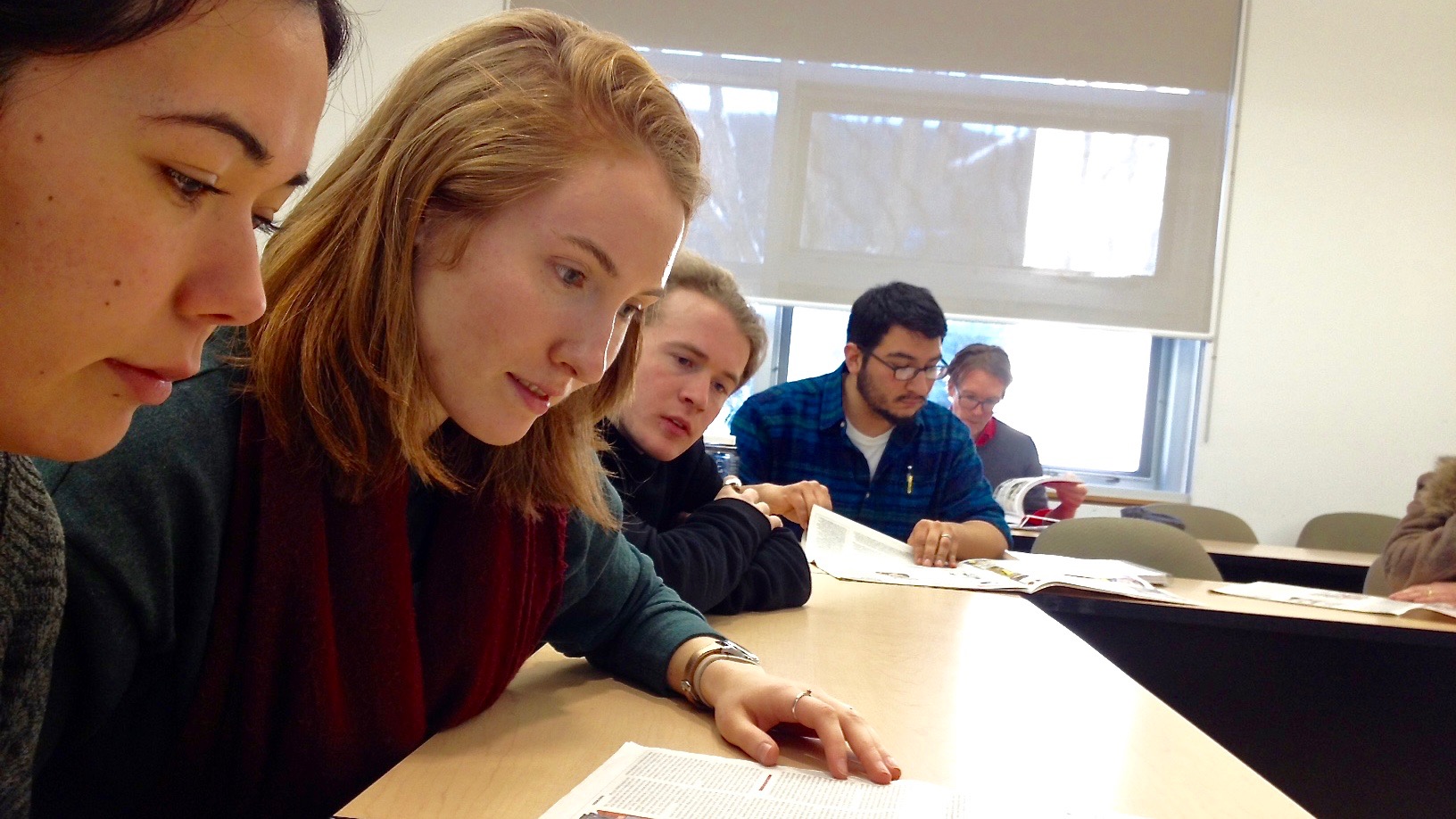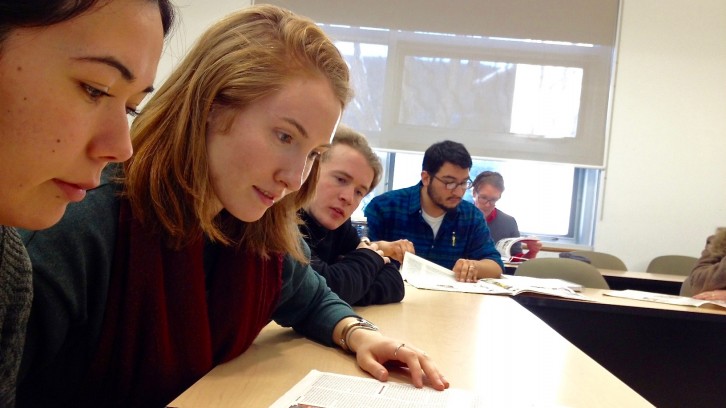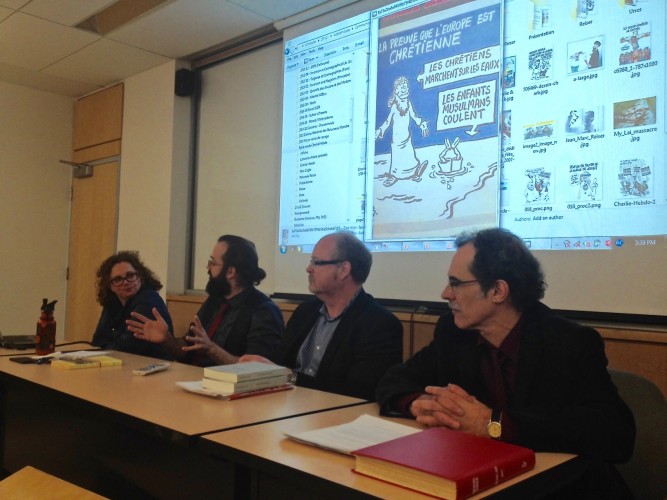Satire
Offended by Charlie Hebdo? It’s impertinent French humour, say academics
One year after the attack on Charlie Hebdo, academics met to deconstruct the magazine’s vulgar, coarse — but staunchly leftist agenda at Dalhousie University

caption
Students examine a recent issue of Charlie Hebdo.
caption
Students examine a recent issue of Charlie Hebdo.A year after the office of the satirical magazine Charlie Hebdo was attacked in Paris, the French department at Dalhousie University met to contextualize the killings that rocked the world, spotlighting issues of freedom of speech, racism, censorship, and secularism – and Charlie Hebdo’s consistently controversial content.
https://twitter.com/jesuischarlie_/status/686410379442786304
#CharlieHebdo – Pascal Ory au #JDD: "Les pires crises ont aussi des aspects positifs" https://t.co/zCPrqHiXF2 pic.twitter.com/YAOBvLHLJs
— Le JDD (@leJDD) January 6, 2016
Today we remember victims of attack on #CharlieHebdo & Hypercacher. Dark vision of terrorists will always be outshined by peace, tolerance.
— John Kerry (@JohnKerry) January 7, 2016
When it comes to understanding the motivations behind the publication’s indelicate cartoons, argued the panel to 35 attendees, readers are getting it wrong.
“Many Americans don’t understand exactly what it meant to attack Charlie Hebdo,” said Vincent Masse, an associate professor of French at Dalhousie on Friday. “It’s a spectacular example of cultural miscommunication how some people criticize Charlie Hebdo for its racist cartoons and depictions. In France, Charlie Hebdo — for decades — has been one of the most vocal anti-racist platforms.”
Charlie Hebdo
On Jan. 7, 2015, the now-infamous Kouachi brothers stormed the Parisian offices of Charlie Hebdo and killed 12 people. According to Charlie Hebdo, the murders were an attempt to avenge the Prophet Mohammed, who was visually depicted in a number of satirical cartoons published by the magazine.
Charlie Hebdo produces what it refers to as “humour, food for thought, and satire” on “religions which inspire swarms of fools.” Its other targets? The police, the army and the extreme political right.
Vittorio Frigerio, an undergraduate advisor and professor of French at Dalhousie, says the cartoons “can be misunderstood very easily.”

caption
From left to right: Amal Ghazal, associate professor of history;Vincent Masse, associate professor of French; Christopher Elson,
chair of the French department; Vittorio Frigerio,
undergraduate advisor and professor of French at Dalhousie University. Background photo: recently published Charlie Hebdo cartoon.
Charlie Hebdo “saw their fight as a fight for tolerance and against the intolerance religion poses on society,” he said. “They wanted deliberately to be as aggressive and as offensive as possible towards a religion that shows acts of hate on society.”
It’s not uncommon for the magazine to present left, anti-racist perspectives with a Holocaust or dead baby joke. But if you look at the cartoons through an anti-war, anti-violence, anti-army, anti-religion, anti-anti-semitism lens, said Masse, you start to see a leftist agenda that many people in North America fundamentally agree with.
“One of the main characteristics of French caricature is virulency — impertinence,” said Frigerio. “It can often be quite coarse and the humour can be deliberately vulgar. Vulgarity as a stylistic exercise appears to be a French specialty,” he added dryly.
On Wednesday, Charlie Hebdo found itself once again under fire for publishing a series of cartoons that suggested Alan Kurdi, the three-year old Syrian boy who drowned off the coast of Turkey in September, would have grown up to sexually assault German women.
Charlie Hebdo's "humour":"What would little Aylan become if he'd grown up?". An ape molesting german women. pic.twitter.com/eAvtIPveEk
— Emran Feroz (@Emran_Feroz) January 13, 2016
#CharlieHebdo under fire for depicting drowned Syrian boy as pervert in Germany https://t.co/Jn9JU14vX0 pic.twitter.com/RBbREsf1TP
— RT (@RT_com) January 14, 2016
.@QueenRania responds to controversial #CharlieHebdo cartoon with drawing of her own: https://t.co/Em4AlJr4Rj pic.twitter.com/vB8ykq8X5b
— Women in the World (@WomenintheWorld) January 15, 2016
“I’ve read a dozen different reactions in the international press,” said Frigerio. “Knowing the frame of mind of these artists is that this particular drawing goes beyond the singular case. The image of the drowned child has become a symbol. We’re not talking about one person anymore. [Charlie Hebdo is] putting the reader in front of his own instinctual reactions to two very different events.”
When the image of the Syrian refugee crisis was a drowned toddler, people’s immediate emotional response was to jumpstart the immigration process. When the events in Germany happened, however, the reaction was the exact opposite.
Frigerio suggests the magazine might have been trying to show readers they were dealing with the same people. The cartoon was an illustration of incongruousness.
Frigerio added quickly afterward: “But make up your own mind!”


R
Rachael Kelly